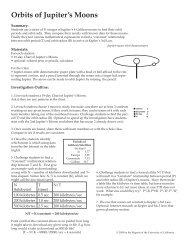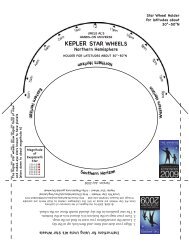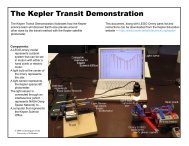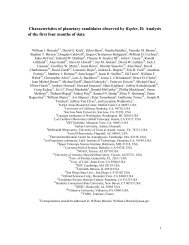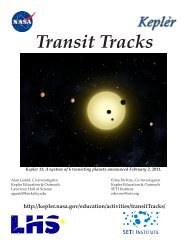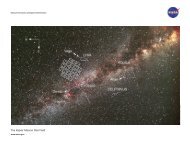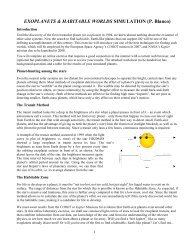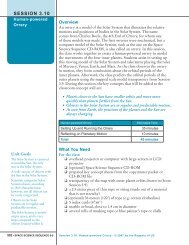Poster Abstracts - Kepler - NASA
Poster Abstracts - Kepler - NASA
Poster Abstracts - Kepler - NASA
- No tags were found...
Create successful ePaper yourself
Turn your PDF publications into a flip-book with our unique Google optimized e-Paper software.
POSTER ABSTRACTSP0107. POSTER SESSION ILINEAR AND NONLINEAR NOISE REDUCTION TECHNIQUES FOR KEPLER DATA. D. L. Buzasi 1 ,1Eureka Scientific, 2452 Delmer St., Ste. 100, Oakland, CA 94602, dbuzasi@gmail.com.The <strong>Kepler</strong> pipeline produces simple aperture photometryon each target, and engineering data and otherdiagnostics are used to remove systematic errors in theresulting time series. Time series are then searched forplanet signatures using an adaptive matched filter(Jenkins et al. 2010), and for stellar oscillations andother astrophysically interesting phenomena using avariety of techniques (Hekker et al. 2011, Mathur et al.2011). Noise levels found in these time series are up to50% higher than originally anticipated for the mission,with a large contribution to the noise level comingfrom intrinsic stellar signals such as activity and granulation(Gilliland et al. 2011).Buzasi (2007) suggested that use of a Wiener filterbased on the known signature of stellar granulationmight improve noise characteristics of the time series.However, this appears to be a significant improvementon the current (mostly time domain) filtering approachonly in certain portions of parameter space. Alternatively,nonlinear noise reduction techniques can beused for such broadband noise spectra. In this paper,we compare the performance of linear and nonlinearnoise reduction on <strong>Kepler</strong> data, with both planetary detectionand stellar oscillation applications in mind.2011 <strong>Kepler</strong> Science Conference - <strong>NASA</strong> Ames Research Center 117



